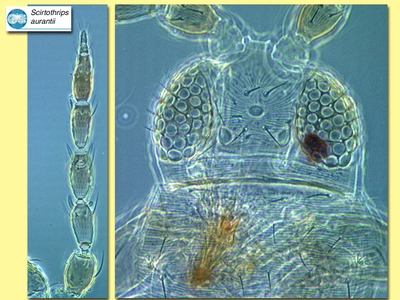Figures
Fig. 1 Antenna and head
Fig. 2 Pronotum
Fig. 3 Fore and hind wing
Fig. 4 Tergite VI and VII
Fig. 5 Sternite IV and V
Species
Scirtothrips aurantii Faure
Biology
Although a major pest of citrus in southern Africa, breeding on young leaves and young fruits, this species is highly polyphagous.
Distribution
Widespread throughout Africa, from South Africa to Egypt and Nigeria.
Recognition
Small pale thrips with weakly shaded forewings and antennae; tergites and sternites each with antecostal ridge dark, tergites with a dark area medially. Antennae 8-segmented, sense cones on III & IV forked, short and stout. Head with one pair of setae in front of fore ocellus, and one pair within the triangle just in front of anterior margins of the posterior ocelli; ocellar region with many transverse striae. Pronotum with many transverse striae, one pair of major posteromarginal setae. Metanotal sculptured striae forming a complex Y-shape, sub-parallel on posterior half and forming elongate reticles, but transverse near anterior margin; median setae close to anterior margin. Forewing first vein with 3 setae on distal half, second vein with 3 widely spaced setae; posteromarginal cilia not quite straight. Abdominal tergites with closely spaced rows of microtrichia on lateral thirds; median setae small and close together; tergite VIII with complete posteromarginal comb of microtrichia. Sternites covered with microtrichia. Male hind femora with characteristic comb of stout setae on inner margin; tergite IX with pair of elongate, dark, lateral drepanae.
Related species
At least 60 species are known in this genus worldwide, mainly from tropical countries, and in Australia there are several more species as yet undescribed. However, the male of S. aurantii is unique in having a comb of setae on the hind femora, and the female is unusual in having the sternites covered with microtrichia.






